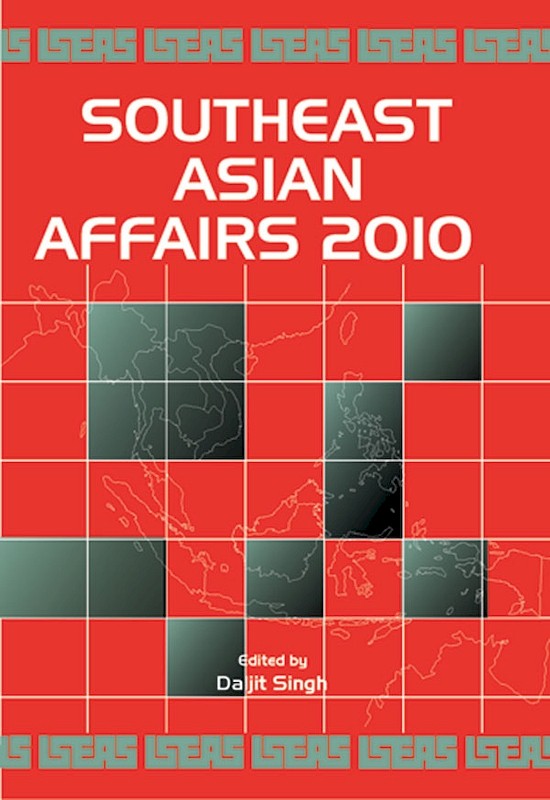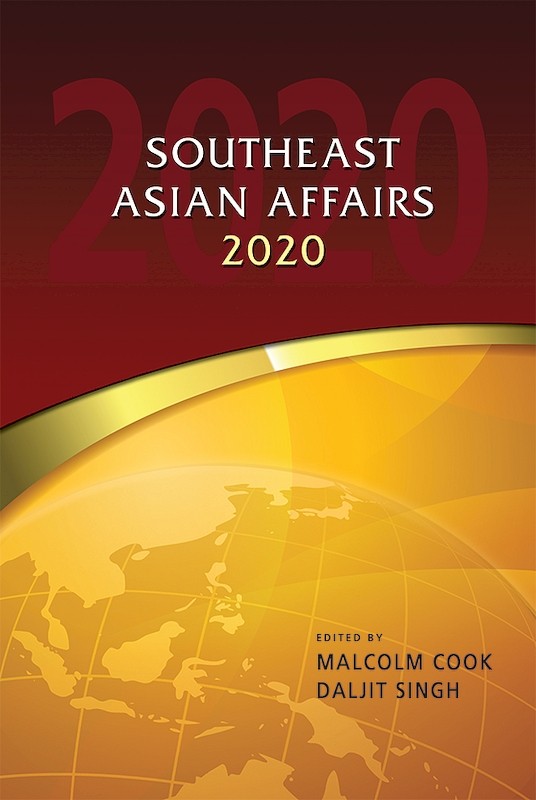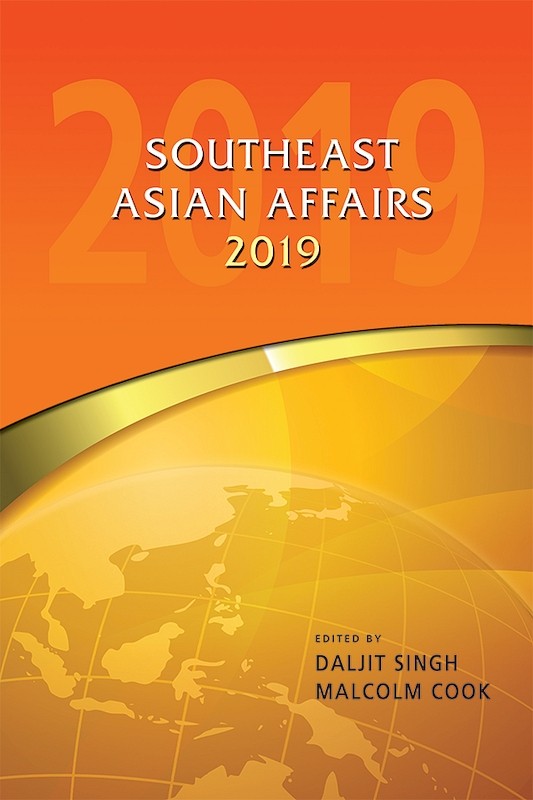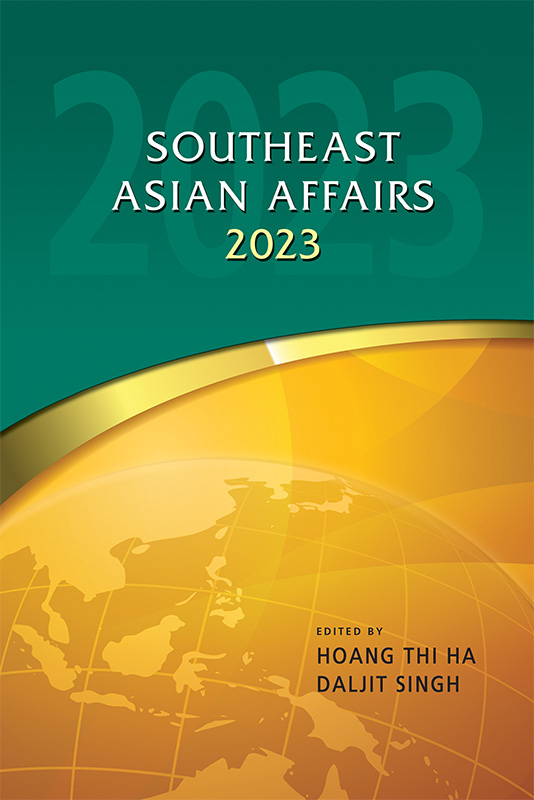Southeast Asian Affairs 2011
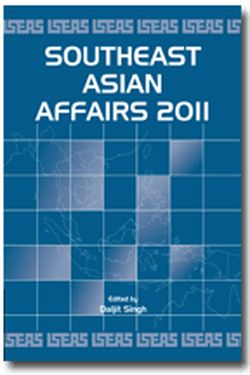
About the publication
"Founded in 1974, Southeast Asian Affairs provides, without fear or favour, informed and in-depth annual analyses of this vibrant region and its component countries. It is the only publication which does this and is in its own class without peers. It is a mandatory reference and read for those seriously interested in knowing Southeast Asia."
- Professor A.B. Shamsul, Founding Director
Institute of Ethnic Studies, Universiti Bebangsaan Malaysia
"Now in its 38th edition, Southeast Asian Affairs offers an indispensable guide to this fascinating region. Lively, analytical, authoritative, and accessible, there is nothing comparable in quality or range to this series. It is a must read for academics, government officials, the business community, the media and anybody with an interest in contemporary Southeast Asia. Drawing on its unparalleled network of researchers and commentators, ISEAS is to be congratulated for producing this major contribution to our understanding of this diverse and fast-changing region, to a consistently high standard and in a timely manner."
- Hal Hill, H.W. Arndt Professor of Southeast Asian Economies
Australian National University
Co-publication: Institute of Southeast Asian Studies
Institute of Southeast Asian Studies
Contents
-
Southeast Asian Affairs 2011
[Whole Publication, ISBN: 9789814345040] -
Preliminary pages
- THE REGION
-
Southeast Asian Economies in 2010: The Challenge of Sustaining Growth after the Recovery, by Thiam Hee Ng, author see abstractSoutheast Asia has staged a strong recovery in 2010, bringing the region back to its pre-crisis level. Regional growth, however, is expected to moderate in 2011 in the face of a weaker external environment and withdrawal of government stimulus. Therefore, the policy focus in 2011 should shift from preventing a recession to sustaining long-run growth. This will require moving away from short-term policies to more long-term structural policies. The region also faces the risks of slower than expected growth in the advanced economies. With anaemic growth in the developed markets, the region should encourage rebalancing demand towards regional and domestic demand. The region also faces the risk of destabilizing capital flows and rising inflation. Greater regional cooperation may be help the region manage capital flows while a tighter monetary and fiscal stance may reduce the risks of higher inflation.
-
The United States, China and Southeast Asia, by Carlyle A. Thayer, author see abstractIn 2010 security in Southeast Asia was affected by three major developments. First, Sino-American relations deteriorated when Beijing suspended military-to-military exchanges with Washington after the United States resumed arms sales to Taiwan. Senior officials exchanged barbs at the Shangri-la Dialogue and the 17th ASEAN Regional Forum. Second, the Obama Administration stepped up U.S. re-engagement with ASEAN. A high-point was reached with the holding of the 2nd U.S. ASEAN Leaders Meeting. Third, Chinese assertiveness in the South China Sea emerged as a hot button security issue. U.S. diplomatic intervention and the offer to facilitate a solution raised Chinese ire. These developments posed serious challenges to ASEAN and its role as the primary driving force in Southeast Asia's security architecture. ASEAN weathered these challenges by inaugurating the ASEAN Defence Ministers' Meeting Plus process and by agreeing to enlarge the East Asia Summit by including the United States and Russia as members.
-
ASEAN in 2010, by Rodolfo C Severino, author see abstractThe chapter on the Association of Southeast Asian Nations reviews the major ASEAN-related developments in Southeast Asia in the year. It notes that for the first time the ASEAN chairmanship coincided with the calendar year, with connectivity in and with Southeast Asia as its theme. It was no coincidence that the Master Plan for ASEAN Connectivity was adopted under Vietnams 2010 chairmanship. ASEAN adopted several measures towards bringing about an ASEAN Economic Community. In 2010, the currency swap arrangements among the ASEAN members, China, Japan and Korea were "mutilateralised and enlarged". 2010 also saw the assumption by the United States of greater prominence in Southeast Asia, holding a second summit meeting with ASEAN and joining, with Russia, the East Asia Summit. ASEAN made some progress on human rights, which was focused on the national and regional elections in Myanmar, the release from house arrest of Aung San Suu Kyi, and the activities of the ASEAN Inter-governmental Commission on Human Rights.
- BRUNEI DARUSSALAM
-
Brunei Darussalam: Consolidating the Foundations of its Future?, by Christopher Roberts, author see abstractPolitical stabilityin Brunei Darussalam - the abode of peace is built on oil wealth and Bruneis citizens subsequently enjoy some of the best standards of living in Asia. This fortuitous state-of-affairs is reinforced by a small population of just 402,000 two thirds of which are ethnic Malays. Nonetheless, a range of short, medium and long-term challenges have compelled the Kingdom to be increasingly innovative and, in some areas, more progressive for the purpose of maintaining long-term Economic and social stability. Such themes were evident in the three sections covered by this chapter. The first section focuses on Brunei's economy. While the economy has not been particularly strong in recent years, the section reveals that some developments have either taken place, or are in the process of being implemented, that may eventually strengthen the foundations for a more robust economy. The second section examines the political environment of Brunei and finds that while there has been little change to the institutions of government, there were a number of subtle policy reorientations for the purpose of responding to past omissions and new problems. The final section examines the countrys foreign relations and developments concerning its defence policy. Here, significant events included Brunei's relations with China together with a final resolution of Brunei's maritime disputes with Malaysia. Overall, 2010 was a crisis free year that enabled the Kingdom of Brunei to refine some of its political and economic policies.
- CAMBODIA
-
Cambodia 2010: Economic Recovery, Governance and Human Rights Shortfalls, by Khatharya Um, author see abstractThe year 2010 for Cambodia was yet again a year of measured optimism as the economy began to recover from the global contraction of the previous two years. The more robust global market has seen to growth in critical sectors, principally textile and agricultural exports, and tourism. Economic recovery was also stimulated by stepped up investment interest and continued infusion of international assistance. The country hosted a number of high profile meetings and state visits, including that of US Secretary of State Clinton and China's Chairman of the Standing Committee of the National People's Congress, Wu Bangguo, that yielded lucrative trade deals and pledges of foreign assistance. Despite these grounds for optimism, the country's social, economic and political development continues to be undermined by the fragility of critical institutions, such as the courts, lack of transparency, accountability and overall good governance, and corruption. Land grabbing, evictions and irresponsible development initiatives continue to disenfranchise communities and engender adverse environmental impact. As the ECCC prepares for the second cluster trials of Khmer Rouge leaders, fundamental issues of human rights and human security remain unaddressed.
- INDONESIA
-
Indonesia In 2010: Moving on from the "Democratic Honeymoon", by Bernhard Platzdasch, author see abstractThe chapter discusses major political developments in Indonesia in 2010. It also includes a brief economic overview. It argues that Indonesia's successful transition to democratic rule has often obscured deeply ingrained deficiencies in the country's political culture. It points to the lack of good governance at the sub-national level. It also highlights that 2010 was a year largely defined by stasis and overshadowed by the political scandal that led to the resignation of Finance Minister Sri Mulyani Indrawati. The chapter also includes a section on inter-religious affairs, arguing that the Yudhoyono government has seen more at stake when it comes to issues involving Islam as compared to minority religions. It has therefore made a number of accommodations to Islamic interests which impinge on the religious freedom of minority groups. In international relations, the visit of U.S. President Obama was significant as it was keenly welcomed by most leaders from the main Muslim organizations, indicating a chance of rebuilding a bridge of trust with Western nations.
-
The Ongoing Extremist Threat in Indonesia, by Sidney Jones, author see abstractIn her chapter "the Ongoing Extremist Threat in Indonesia", Sidney Jones assesses the terrorist and extremist threat. She argues that while significant progress has been made in addressing the terrorist threat, much hard work still remains. The potential for low tech terrorist violence still remains high. Little headway is being made in preventive action like better oversight of prisons housing terrorists. Pervasive corruption in state agencies is a huge obstacle in the fight against terrorism. Above all, the government's lack of action against non-terrorist extremism serves the jihadi cause.
- LAOS
-
Laos: Celebrations and Development Debates, by Simon Creak, author see abstractThe past year in Laos was one of grand celebrations and anniversaries. Bookended by the Southeast Asian (SEA) Games and the 450th anniversary of Vientiane as capital, these celebrations were significant not only in their own right but also for the insights they offer into recent developments in economics, foreign relations and politics. Festivities took place against the backdrop of robust economic growth as the Lao economy bounced relatively unscathed through the Global Financial Crisis, allowing the ruling Lao Peoples Revolutionary Party (LPRP) to present the celebrations as evidence of increasing national prosperity as well as pride and patriotism. The national celebrations and the economy also highlighted foreign dependencies in Laos, fuelling debates at the core of development policies. Rather than being taken over by China and other regional powers, however, foreign investment and aid appear to be consolidating power under the authoritarian LPRP regime, although authority continues to be contested within the party.
- MALAYSIA
-
Malaysia in 2010: Resurgent Najib and BN, Stumbling Anwar and PR, by Ong Kian Ming, author see abstractThe year 2010 was notable in marking the contrasting political fortunes and changes in political momentum on the part of Najib Tun Razak, the Prime Minister and leader of the ruling BN coalition on the one hand and Anwar Ibrahim the leader of the PR opposition coalition and of PKR, his own party. While Najib saw a significant increase in his approval ratings from his various transformation programmes and initiatives, Anwar's party was hit by high profile defections and a national party election that was marred with allegations of electoral management and fraud which culminated in the resignation of former UMNO cabinet minister and high profile PKR leader, Zaid Ibrahim. The political momentum carried by Najib into 2011 puts the BN coalition in a strong position to regain back a two-thirds parliamentary majority, should a general election be called in 2011. However, doubts about how well the BN would do in the upcoming Sarawak state elections remain.
-
Malaysia "Punching Above Its Weight" ... And Finally Hitting the Target, by John Lee, author see abstractDespite very public diplomatic spats with Washington from 1998 onwards, Malaysia was one of the first countries in the region to develop and follow a strategic hedging blueprint of taking economic advantage of China's rise while hedging against future Chinese ambitions and behaviour by maintaining close bilateral security ties with the United States. From 2010 onwards and in the face of a more muscular Chinese diplomacy in the region, there is a common perception that Malaysia has moved "closer" to the US. The paper notes that Malaysia's recent attempt to help enhance and entrench American multilateral engagement is a new development. But it also argues that the Prime Minister Najib Razaks "new beginning" with the United States does not represent a fundamental change in Malaysian grand strategy but a disciplined, creative, and timely return to its long-standing hedging blueprint.
- MYANMAR
-
Myanmar in 2010: The Elections Year and Beyond, by David I Steinberg, author see abstractThe new, military-dominated Myanmar government was reincarnated from the State Peace and Development Council in late January 2011 following the 7 November 2010 elections. It may have believed that the new constitution had resolved the political relations with minority cease-fire groups, which have been titularly given more voice in Burmese affairs since 1962. If so, they are likely to have been mistaken. The critical Border Defense Force issue remains unresolved, and the powers of the newly formed minority State Hluttaws (legislatures) are untested. China's predominant economic interests and infrastructure development continue to be apparent, but the old and new Myanmar governments seem interested in increasing its international relations without diminishing its hold on authority. Indian and Vietnamese contacts expanded. North Korean support to the Burmese military and even rumours of nuclear cooperation have caused international anxiety. Relations with the U.S., however, showed little sign of change, even with the welcome release of Aung San Suu Kyi from house arrest. The U.S. administration's "pragmatic engagement" (sanctions and high-level dialogue) is still hostage to a bipartisan devotion to her interests and role; the future of both internally remain unclear. The increased economic resources available to the state have not resulted in improvement in the lives of the people. Planned Thai economic activities in Myanmar on the Bay of Bengal have raised important environmental issues. Myanmar in the next few years may chair ASEAN, but to what positive effects remain unclear.
-
Elections 2010: Continuity and Change, by Tin Maung Maung Than, author see abstractThe 2010 multi-party general election was the fifth and crucial stage of the seven-step Road Map announced by the ruling State Peace and Development Council (SPDC) in August 2003. It was the manifestation of Myanmar military's managed transition towards a civilian government while at the same time ensuring continued military dominance of the political space and the Myanmar state. It was the culmination of the long drawn out series of preparations carried out by the junta in the aftermath of the 1990 election which had not produced a change in government. As expected, the Union Solidarity and Development Party (USDP), formed with incumbent ministers and led by the prime minister, won over 70 per cent of the contested seats in the bicameral national parliament and in the 14 provincial parliaments though ethnic-based parties made some inroads in their respective states. Combined with the mandatory 25 per cent military representation in all parliaments the USDP will have a super majority to dominate the proceedings.
- THE PHILIPPINES
-
Philippines in 2010: Reclaiming Hope, by Edilberto C de Jesus, author see abstractThe election in May as president of "Noynoy" Aquino, the oldest offspring and only son of assassinated, anti-Marcos political leader Benigno Aquino, Jr., and Corazon C. Aquino, was the defining political event of 2010. The death of Cory Aquino in August 2009 and the national platform provided by the wake and the internment ceremonies propelled Aquino into the presidential campaign. His election revived hopes for renewal akin to those inspired by the1986 EDSA People Power Revolution that made Cory Aquino president. Noynoy Aquino handily defeated Joseph "Erap" Estrada, who had been forced out of the presidency by People Power II in 2001. Gloria Macapagal Arroyo, the beneficiary of EDSA People Power II, which promoted her to the presidency left vacant by Estrada, had posed the more difficult challenge. Elected to Congress after nine years as president, Arroyo and her allies remain a threat to the success of Aquino'spresidency.
-
Balancing Gambits in 21st Century Philippine Foreign Policy: Gains and Possible Demise?, by Renato C de Castro, author see abstractThis article examines how the Philippines is engaging both the United States and China in a delicate balancing gambit. This gambit involves the Philippines participation in the U.S.-led war on terror to secure crucial American economic and security assistance; and efforts to engage an emergent China to make it an important market for the countrys exports. It, however, observes that the Philippines' balancing gambit is in a precarious shape as domestic and systemic forces are slowly unravelling this fragile state of affairs. These forces are: the Philippines' general passive role; the current dynamics in U.S.-China relations; China's growing assertiveness with regard to its maritime claim in the South China Sea; and Manila's slow drift to Washington in the face of the increasing tension in the Spratly Archipelago. In conclusion, the article warns the Philippines might find it too late that in international politics nothing good last forever.
- SINGAPORE
-
Singapore in 2010: Rebounding from Economic Slump, Managing Tensions Between a Global City and a Fledging Nation State, by Faizal Yahya, author see abstractSingapore in 2010 had emerged from the devastating effects of the global financial crisis of 200809. The economy achieved double digit growth. The economy received a boost with the opening of the two Integrated Resorts (IRs) including the casinos. However, the volatility of the global economy raised uncertainties going into the future. There were concerns about how the vulnerable groups and lower - income Singaporeans would be supported. The Budget of 2010 had placed emphasis on skills, innovation and productivity but would that be enough to sustain economic growth in the long term? In successfully hosting the inaugural Youth Olympic Games (YOG), Singapore's visibility was enhanced globally. Yet, the pressure to balance the twin demands of being a global city and a nation state remained a major challenge.
-
Goh Keng Swee: Thinker and Institution Builder, by Ooi Kee Beng, author see abstractBeyond strong personalities, the building of a nation requires the establishment of stable and effective institutions. These function as facilitators of policies formulated in response to challenges that often came as surprises to national leaders. Few cases of institution building have been as rationally and impressively carried out as in Singapore. Much of the credit for this has to go to Dr Goh Keng Swee. Especially in his role as the country's first Finance Minister and its first Defence Minister, he founded institutions that effectively solved the many dilemmas that the island nation faced in its first decades of existence.Be it self-rule in 1959, the separation from Malaysia in 1965; the withdrawal of the British army by 1971, or the Opec Crisis of 1973, each turn of events witnessed quick responses whose impact has been curiously durable.
- THAILAND
-
Thailand in 2010: Struggles and Transformations of the Emergency State, by Michael Connors, author see abstractThailand's political landscape in 2010 was dominated by the ravine-like political division over the rules that define the acceptable exercise of power. Fatal clashes between the United Front for Democracy Against Dictatorship and the Royal Thai Military between April and May left over ninety people dead and thousands injured. Previous episodes of mass protest and state repression, such as those in 1973, 1976 and 1992, have come to define new political eras. It remains uncertain as to whether the same may be said of the April-May killings, or if those events are part of a series, as yet unfinished, of increasingly unpredictable political struggle.
-
Competing Diplomacies: Thailand Amidst Sino-American Rivalry, by Pavin Chachavalpongpun, author see abstractThailand's protracted political crisis continues to shape the contours of the country's foreign policy, especially in its relations with the great powers - in this case, the United States and China. It has provided a vital platform for the two powers to compete with each other to preserve their strategic ties with Thailand as well as to consolidate their sphere of influence in this part of the world. Arguably, the Thai political situation has further intensified the level of such competition, which has in turn readjusted the overall balance of power in Southeast Asia. This chapter examines the different approaches of the United States and China in dealing with the Thai crisis. It asks: Which approach is more effective in the attempt to win the Thai influence? How has the competition come to dominate Thailand's foreign affairs? And what is the role of ASEAN, of which Thailand is a member, in the Sino-U.S. rivalry for influence in the kingdom?
- TIMOR-LESTE
-
Timor-Leste In 2010: On the Road to Peace and Prosperity?, by Dennis Shoesmith, author see abstractIn 2010 Timor-Leste continued its second year of relative political stability after earlier crises. Division between Prime Minister Gusmao and two of the parties in his AMP coalition government signalled, however, a destabilizing development in national politics. The Prime Minister attacked his second Deputy Prime Minister and his Foreign Minister, both senior leaders in the PSD party, forcing the Deputy Prime Minister to resign. The Prime Minister promoted, on a country-wide tour, a highly ambitious development plan. The plan, which involves large-scale spending from the Petroleum Fund, may be driven as much by his strategy to win voter support in the forthcoming and critical 2012 elections. The larger risk is that "money politics" will subvert democratic politics in Timor-Leste.
- VIETNAM
-
Vietnam in 2010: Familiar Patterns and New Developments Ahead of the 11th Party Congress, by Edmund Malesky, Paul Schuler, Anh Tran, authors see abstractThis article reviews the events of 2010 in Vietnam, showing that in many ways this year resembles other preparatory years for the Congress. The important events we discuss such as economic policy choices, the jailing of dissidents, corruption scandals, and an increase in criticism and ideas circulating through the media and internal Party circles, fit the general pattern of competing interests vying for power and policy change that has preceded previous Party Congresses. Nevertheless, we demonstrate that a fascinating change has been evident throughout the various episodes, which augurs well for Vietnam's future political development. The slow liberalization of the state institutions has now shifted the forum for much of this elite contestation. Rather than occurring exclusively in secluded party institutions and leaked into the public realm only through targeted state-media revelations, some contestation is occurring within the states representative institutions, and in particular, the Vietnamese National Assembly (VNA).


